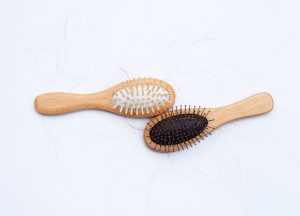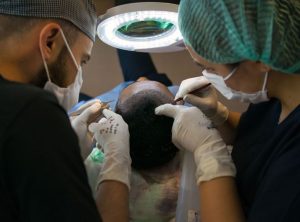Short hair lovers, your dream of natural, permanent hair restoration is now a reality, thanks to FUE.
Have you thought about how nice it would be to have a stronger, more flattering hairline to frame your face? If you have hesitated to have hair restoration surgery due to concerns that you will need to wear your hairstyle longer for fear of a visible scar, FUE may be the donor removal option for you. There are currently two techniques commonly used for donor removal: follicular unit transplantation (FUT), and follicular unit extraction (FUE).
Follicular Unit Extraction (FUE)
FUE refers to a technique where each graft is removed individually using a small biopsy-type excision. Although tiny “dots” will result when the FUE grafts are removed, for most patients, these tiny dots are usually invisible, even at a very short hair length.
This means you can typically wear your hair as short as a #1 blade, and not worry that there will be visible tell-tale signs. Other factors such as hair and skin color make a difference too. While there is no scarless procedure for donor hair removal, FUE scars are tiny enough that the small speckles are typically not seen, even with very short hairstyles.
FUE: Pros
There are additional advantages to FUE. Although FUE involves thousands of tiny excisions, patients say they have minimal discomfort during the healing phase. If you have had prior hair transplants and there is insufficient laxity for further donor removal with the linear excision, FUE may allow you to add more grafts. You also have the option to fill in a scar left from a prior linear excision procedure with FUE to allow you to wear your hair short again.
The length you will need to wear your hair where the donor is removed depends on the thickness and color of your hair in the permanent zone regardless of technique. However, for those who prefer to be able to wear their hair buzz cut as close as a #1, or with a fade in the back of your head, you would be more likely to be able to do that with the FUE donor removal option.
FUE: Cons
However, there are some caveats that you should also weigh when deciding if FUE is suitable for you. The donor area will need to be shaved. It will regrow but you will need to keep in mind that this will be necessary. That is not the case with the FUT donor removal.
Additionally, the number of grafts able to be taken from the donor area with FUE in a single session compared to the linear excision is less. This is because we can remove about 10 to 15 grafts per sq. cm from the permanent zone with FUE, compared to about 70 grafts per sq. cm with the linear excision.
How FUE Hair Transplant Is Done
Follicular Unit Extraction (FUE) hair transplant is a minimally invasive surgical procedure that involves extracting individual hair follicles from the donor area (typically the back and sides of the scalp) and transplanting them to the balding or thinning areas of the scalp. Below is a guide on how an FUE hair transplant is done:
Preparation
The procedure begins with cleansing your scalp and numbing it with local anesthesia. Your surgeon will then mark the donor and recipient areas.
Graft Extraction
Using a tiny punch tool, your surgeon will extract individual hair follicles from the donor area using a punch device specialized for harvesting follicular units. The follicles are meticulously removed to ensure viability.
Graft Preparation
Once the follicles have been extracted, they are cleaned and prepared for transplantation. This involves trimming the excess tissue from the follicles.
Site Creation
In the recipient area, the surgeon will create tiny holes or incisions using a needle or blade. These holes will serve as the new homes for the transplanted follicles.
Graft Implantation
Using fine forceps, the surgeon will meticulously implant the follicles into the prepared sites at the precise angle and orientation to ensure natural-looking results.
Recovery
The recovery time for an FUE hair transplant is typically short. Most patients are able to return to work within a few days. The transplanted hair will start to grow within a few months, and you can expect the full results of the procedure within 12-18 months.
Donor Area Considerations in FUE Hair Transplant
Keep in mind that donor hair should be removed from an area where it is most likely genetically permanent because the transplanted hair will retain the genetic characteristics of the area where it is taken from.
The area where donor hair is most available is located centrally on the back and sides of the scalp (with androgenetic alopecia), and it is finite. If the donor hair is taken peripherally either too high or too low from the back and sides of the head, the risk is that you may recede downward from the crown, or even upward from the neck.
So with a finite area to draw from, and fewer grafts removed per square cm, FUE will not cover as large of an area as the linear excision donor removal method in a single session. However, you are able to return for further FUE grafts once the area heals.
The graft placement techniques remain the same regardless of the donor removal technique, and in the hands of Dr. Keene, a skilled surgeon with over two decades of experience in the field of hair transplant and the President of Physician’s Hair Institute, you will achieve a full head of hair that looks remarkably natural.
We Don’t Just Restore Hair. We Restore Confidence.
If you’re tired of dealing with hair loss and dream of a fuller head of hair that looks completely natural, what’s stopping you from making a change?
Contact Arizona’s top hair transplant clinic at 520-290-5555 or 800-840-9761 to schedule a consultation today. We serve patients in Phoenix, Scottsdale, Chandler, Glendale, Paradise Valley, Mesa, and surrounding areas.




